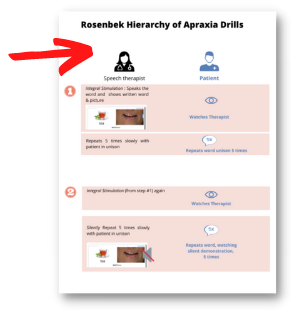Rosenbek Hierarchy of Apraxia Therapy
Help patients speak more clearly with these clinically proven 8 steps
Why apraxia can feel like a brick wall
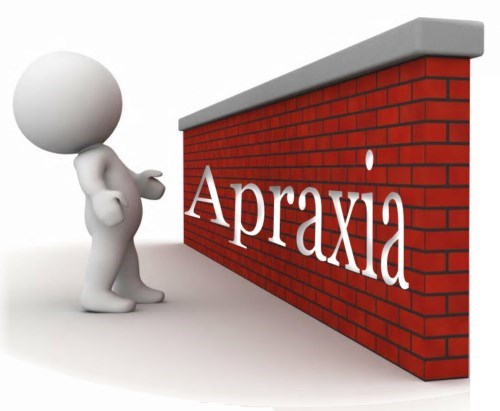 Apraxia
causes difficulty coordinating the mouth & tongue to
produce speech.
Apraxia
causes difficulty coordinating the mouth & tongue to
produce speech.
We use speech so often (and so effortlessly) that we forget just how complex and difficult it is to learn. If you've ever tried to teach a baby to speak, you know it's not easy. In addition, apraxia is often accompanied by expressive aphasia, causing difficulty with word-retrieval (thinking of the right word). I call that the double whammy: you have difficulty thinking of the word and then, even if you think of it, you have trouble saying it.
Trying harder is not the answer
The Rosenbek Hierarchy breaks a hard task (speaking on demand) into small doable steps. It's particularly useful for speech apraxia in adults (might be called dyspraxia outside the U.S.)
Imagine you are trying to get over a five-foot wall.
You can't jump five feet straight up no matter how hard you try. The solution is not to jump higher. Instead, get a ladder. That breaks the impossible five-foot jump into a series of achievable six-inch steps. Dr. Rosenbek provided similar therapy steps for acquired apraxia of speech.
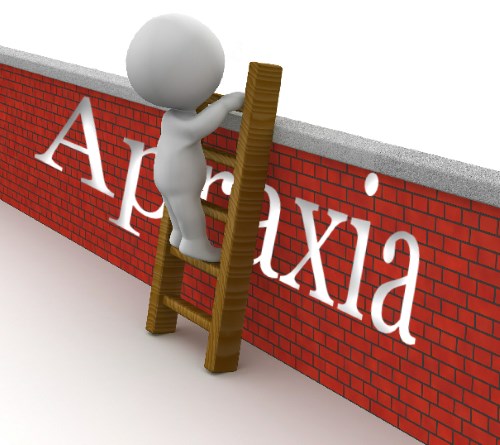
The Rosenbek Hierarchy breaks apraxia therapy into small, achievable steps
A continuum of steps from easy to hard – for each word
Step 1 is the easiest, with maximum help. They see the following cues: picture, the word, and the therapist's mouth speaking the word.
Next steps get harder, with less help.
The survivor may not make it to the
last step for that word. That's okay. If they get to a step they
cannot do, they just go to step 1 of the next word.
Example: Patient gets stuck on step 3

Step-by-step instructions for the Rosenbek Continuum |
|||
| Helper gives
cues |
Survivor responds | ||
| 1 | Demonstrate with Integral
Stimulation.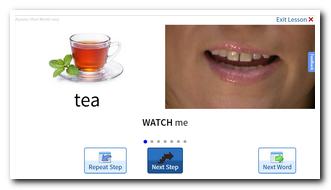 |
Watches demonstration then repeats in unison
with the therapist 5 times. |
|
| 2 | Demonstrate, pause, then silently
mouth the word.
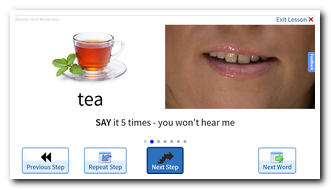 |
Repeats back while watching a silent demonstration. | |
| 3 | Demonstrate, then
pause for survivor to repeat back without
assistance. |
Repeats back, seeing only picture and text. | |
| 4 | Same as #3. | Same as #3 but repeat it 5 times, with only picture and text cues. | |
| 5 | Show the written word and picture.  |
Names the picture. | |
| 6 | Show the written word and picture, then hide them, and prompt
the patient to say the word. |
Names the picture from memory. | |
| 7 | Prompt with a question. I'd like a cup of herbal_____ 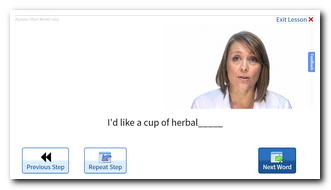 |
Answers the question with a single word (the target word). | |
| 8 | Optional: Role play a
situation that would prompt the survivor to say the word. |
Speaks the word in response to the situation. | |
Video of Rosenbek's
Hierarchy
of Integral Stimulation
Demonstrated by speech-pathology grad student:
Clinician-oriented video of Rosenbek's Hierarchy, including research basis:
Practice the Rosenbek apraxia therapy
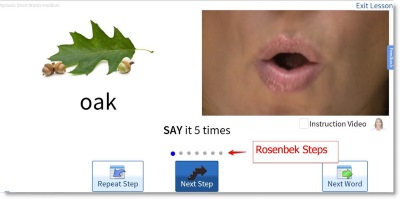 Two
software programs provide therapy for apraxia of speech for adults or
older children:
Two
software programs provide therapy for apraxia of speech for adults or
older children:
MoreSpeech.com
This web-based app includes apraxia skills, which are based on the above approach. It starts with easy words and works up to harder words.
Try it risk-free three ways:
- Start a subscription to MoreSpeech with a money-back guarantee.
- Request a free tour and mention Rosenbek.
- Speech therapists: request a free trial of MoreSpeech with a work email and mention "Try Rosenbek". Survivors, ask your therapist to request a trial and show it to you.
Speech Sounds On Cue
This is a better option for more severe apraxia of speech. It starts at the easier alphabet exercises and then moves on to easy words. They also get more assistance, hearing their own speech played back. Speech Sounds On Cue is included in our monthly subscription.
Try it with a free therapy plan (choose the articulation skill).
Video demo
Free Treatment Materials for SLPs
- Printable Worksheets (Aphasia, Apraxia, Writing, Reading, Auditory Comprehension)
- Clinically proven treatment protocols you can use today.
- Clever cognitive therapy designed for real-world carryover
- And more, delivered free every week.
- We also have a home therapy course specifically for caregivers.
Footnotes and Research Summary
The Rosenbek Apraxia Hierarchy was developed by Dr. John C. Rosenbek and his colleagues in the 1970s. It's sometimes called Integral Stimulation because it integrates sensory cues: seeing a picture and the word, seeing and hearing the therapist model the word.
The Apraxia of Speech protocol developed for the MoreSpeech.com app is based on accepted and commonly conducted clinical practice and research articles demonstrating improved outcomes published in peer-reviewed professional journals including the seminal work "A Treatment for Apraxia of Speech in Adults"
The treatment used in the MoreSpeech app incorporates the stimulation/facilitation model. Duffy & Coelho (2001) provides an excellent description and analysis of Schuell (1953, 1964, 1974) original theory and the subsequent work of researchers who support the concepts that:
- Sensory stimulation influences brain activity;
- Repetition of sensory stimulation is needed for acquisition, organization, and retrieval of patterns of behavior;
- The auditory modality is central to acquisition and maintenance of language;
- The auditory modality is severely compromised for most aphasic people; and
- If aphasia is defined as a multimodal language impairment, then intense stimulation treatment should be directed through the auditory modality because of its essential role in language processing.
Research on treatment approaches to apraxia (and dyspraxia) in adults
Rosenbek, J. C., Lemme, M. L., Ahern, M. B., Harris, E. H., & Wertz, R. T. (1973). A treatment for apraxia of speech in adults. Journal of Speech and Hearing Disorders, 38, 462–472.Schuell, H. (1953). Auditory impairment in aphasia: Significance and retraining techniques. Journal of Speech and Hearing Disorders, 18, 14-21. Schuell, H., Jenkins, J. J., & Jiménez-Pabón, E. (1964). Aphasia In Adults. New York: Harper & Row.
Wambaugh, Julie L., Doyle, Patrick J., Treatment for Acquired Apraxia of Speech: A Review of Efficacy Reports, Clinical Aphasiology; Vol. 22, 1994, pp 231-243
Rosenbek J. C., Wertz, R. T., Darley, Oral Sensation and Perception in Apraxia of Speech and Aphasia, Journal of Speech, Language, and Hearing Research
Schuell, H. (1974). Aphasia theory and therapy: Selected lectures and papers of Hildred Schuell (Sies, L. F., Ed.). Baltimore: University Park Press
Every day is an opportunity for recovery. Don't miss a single day.
- Surprising neuroscience discovery that makes recovery possible at any age.
- Why embracing failure leads to faster recovery.
- Unlock your survivor's communication needs in 4 steps.
- How to improve speech & language at the kitchen table.
Clay Nichols
Co-founder of
MoreSpeech and
Bungalow Software
for unlimited speech therapy at home and in the clinic.
 For
3 decades, Clay has helped patients, caregivers and speech pathologists
with speech & language software. He is not a speech-language
pathologist.
For
3 decades, Clay has helped patients, caregivers and speech pathologists
with speech & language software. He is not a speech-language
pathologist.
© 2025 Bungalow Software
